Darrell Waltrip
| Darrell Waltrip | |||||||
|---|---|---|---|---|---|---|---|
| Date of birth | February 5, 1947 | ||||||
| Hometown | Owensboro, Kentucky | ||||||
| Awards |
1985 Winston Cup Champion 1982 Winston Cup Champion 1981 Winston Cup Champion Named one of NASCAR's 50 Greatest Drivers (1998) 2005 International Motorsports Hall of Fame Inductee Sprint All-Star Race I Champion 2003 Motorsports Hall of Fame of America inductee |
||||||
| NASCAR Sprint Cup Series statistics | |||||||
| 809 races run over 29 years | |||||||
| Best finish | 1st - 1981, 1982, 1985 (Winston Cup) | ||||||
| First race | 1972 Winston 500 (Talladega) | ||||||
| Last race | 2000 NAPA 500 (Atlanta) | ||||||
| First win | 1975 Music City USA 420 (Nashville) | ||||||
| Last win | 1992 Mountain Dew Southern 500 (Darlington) | ||||||
|
|||||||
| NASCAR Nationwide Series statistics | |||||||
| 95 races run over 14 years | |||||||
| Best finish | 22nd - 1986 | ||||||
| First race | 1982 Mello Yello 300 (Charlotte) | ||||||
| First win | 1982 Miller Time 300 (Charlotte) | ||||||
| Last win | 1989 Goody's 300 (Daytona International Speedway) | ||||||
|
|||||||
| NASCAR Camping World Truck Series statistics | |||||||
| 17 races run over 6 years | |||||||
| Best finish | 37th - 1996 | ||||||
| First race | 1995 Heartland Tailgate 175 (Heartland) | ||||||
|
|||||||
Darrell Lee Waltrip (born February 5, 1947) is a 3-time NASCAR Cup Series champion (1981, 1982, 1985), 3-time runner-up (1979, 1983, 1986), winner of the 1989 Daytona 500 and 5-time winner of The Coca-Cola 600 (formerly the World 600), (1978, 1979, 1985, 1988, 1989; a record for any driver). He is the winner of 84 Cup Series races (most by any driver in the modern era and tied for third on the all-time list) and winner of 59 Cup Series pole positions (second all-time), including 35 on short tracks and 8 on road courses (both all-time highs in the series). He has 271 top-five finishes, 390 top-ten finishes, and competed in 809 Cup Series races spanning 29 years (1972–2000).
In addition to NASCAR's top racing series, he has won 13 NASCAR Busch Grand National Series races, 7 American Speed Association (ASA) races, 3 IROC races, 2 Automobile Racing Club of America (ARCA) races, 2 NASCAR All-American Challenge Series events, 2 All Pro Racing Association races, 2 NASCAR All-American Challenge Series events, a USAC race, and has competed in the 24 Hours of Daytona, a 24-hour sports car endurance race.
Waltrip also became the first NASCAR driver to win $10 million (February 18, 1990). He is a 2-time winner of NASCAR's Most Popular Driver Award, (1989, 1990), was "American Driver of the Year", (1979, 1981, 1982), and was "NASCAR's Driver of the Decade", (1980s). In addition, he was the "National Motorsports Press Association Driver of the Year", (1977, 1981, 1982), the "Auto Racing Digest Driver of the Year", (1981, 1982) and the first "Tennessee Professional Athlete of the Year", (1979). He is a 2003 Motorsports Hall of Fame of America inductee and a 2005 International Motorsports Hall of Fame inductee, and was a nominee for the inaugural NASCAR Hall of Fame induction class of 2010. Waltrip was named one of NASCAR's 50 Greatest Drivers (1998). On July 1, 2010, it was announced that Waltrip was one of 25 nominees for the 2011 induction class of the NASCAR Hall of Fame.
Waltrip currently owns Honda, Volvo and Subaru auto dealerships in Franklin, Tennessee, and is a current television race commentator with Fox Broadcasting Company, and Speed TV, an author, and columnist at Foxsports.com. He is the older brother of NASCAR driver and MWR team owner Michael Waltrip. He is married, has two daughters and resides in Franklin, Tennessee.
Contents |
Career as Driver
Early career
Local Short-Track racer
Waltrip was born in Owensboro, Kentucky. Starting his driving career in go-karts at age 12, Waltrip entered his first stock car race just four short years later. Waltrip and his father built a 1936 Chevrolet coupe and headed to a local dirt track near their Owensboro, Kentucky, home. The first night out was far from a success as the youngster, barely old enough to drive on the street, slammed the wall and heavily damaged the coupe. Waltrip soon left the dirt and found his niche on asphalt where the smoothness he learned in the karts proved a valuable asset. He was an early racer at the Kentucky Motor Speedway (an asphalt track in Whitesville) and Ellis Raceway (a dirt track on US Highway 60 west in Daviess County, (now closed), near his Owensboro home, driving a car called 'Big 100' built by Harry Pedley, owner of Pedley's Garage, on West Second Street, in Owensboro, and still in business today. Waltrip's success gained the attention of Nashville owner/driver P. B. Crowell, who urged Waltrip to move to the area to race at the Music City Motorplex, at the Tennessee State Fairgrounds in Nashville, where he would win two track championships, in 1970, and 1973. Waltrip drove the #48 P. B. Crowell owned Ford sponsored by Harpeth Ford, in Franklin. There, he would aggressively promote the week's race when he appeared on a local television program promoting the speedway's races, and was not afraid to embrace the local media when other competitors refused. Some of the notorious trash-talking on air included making fun of drivers such as Coo Coo Marlin (whose son Sterling) later raced at the circuit and is a two-time Daytona 500 winner) and James "Flookie" Buford, whose nickname he would mock on air.
While some fans didn't like it, it pleased track management that he was helping sell tickets, leading to extra paychecks from track operators for his promotional skills. He also embraced WSM radio host Ralph Emery during his early years, forming a bond which would be influential during his career, as Waltrip would later substitute for Emery in the 1980s on Emery's television show, Nashville Now on the former TNN cable network (now Spike). Waltrip would use the success he enjoyed at the Music City Motorplex, and his notoriety and public speaking skills from television appearances in Nashville, as a springboard into NASCAR's big leagues.
NASCAR career
Early years in NASCAR
1972-1975
Waltrip started in NASCAR Winston Cup, NASCAR's top racing series, on May 7, 1972, at the 1972 Winston 500, at Talladega, Alabama, with a used Mercury Cyclone which was originally the 1967 Ford driven by Mario Andretti to victory in the 1967 Daytona 500. Waltrip finished 38th in his first NASCAR Winston Cup race after retiring on lap 69 due to engine failure. The car was owned by Waltrip and sponsored by Terminal Transport of Owensboro, Kentucky, was Waltrip's first major sponsor.
The early years found Waltrip competing against legendary stock car racers such as Richard Petty, David Pearson, Cale Yarborough, and Bobby Allison among others. Brash and outspoken, Waltrip soon earned the respect of his more experienced piers. He was given the #95 as a number but Waltrip wanted car #17 because his hero, David Pearson, had success with the number. As an owner/driver, Waltrip ran 5 races in 1972, 14 races in 1973, 16 races in 1974, with 7 top-five finishes, and 17 races as owner/driver in 1975, with his first Winston Cup victory coming May 10, 1975, the track where he won 2 track championships in Nashville, Tennessee, in the #17 Terminal Transport Chevrolet, a car Waltrip owned.
During the 1973 season, Waltrip drove 5 races for Bud Moore Engineering.
DiGard years
1975-1980
Except for 5 races in 1973, driving for Bud Moore Engineering, Waltrip primarily drove his own cars at the beginning of his NASCAR career until the middle of the 1975 Winston Cup season when he was signed to replace driver Donnie Allison to drive the #88 DiGard Chevrolet. The DiGard racing team was founded in part by Mike DiProspero and Bill Gardner, who were brothers-in-law, with Robert Yates as engine builder. Waltrip’s first race with DiGard came on August 17, 1975, at the Talladega 500, Talladega Superspeedway, in Talladega, Alabama, finishing 42nd after experiencing engine failure. Waltrip would compete in ten more races in the 1975 season for DiGard, sponsored by Terminal Transport, and get his second career NASCAR Winston Cup victory October 12, 1975, in the Capitol City 500, in Richmond, Virginia. He would post 3 top-five and four top-ten finishes in the 11 races he ran for DiGard in 1975.
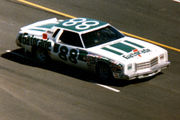
During the early years of Waltrip's career, his wife, Stevie Waltrip, was the first NASCAR wife to attend the races and sit in the pit box, something almost all the NASCAR wives now do. Stevie learned to calculate gas mileage, a hugely important function in the sport, and would monitor the race listening to race communications between the crew chief and Waltrip.
In 1976, Gatorade became Waltrip’s primary sponsor as he started his first full race season driving the DiGard Gatorade Chevrolet. Waltrip won only 1 NASCAR Winston Cup race in 1976, the Virginia 500, at Martinsville Speedway in Ridgeway, Virginia, but in 1977 and 1978, he won 6 times each year, including his first of a record five career victories in the prestigious Coca-Cola 600 (formerly the World 600), May 28, 1978.
In the 1979 season, Waltrip won 7 NASCAR Winston Cup races and was a serious contender for what would have been his first NASCAR Winston Cup Championship. At the start of the final race of the season, the Los Angeles Times 500, at Ontario Motor Speedway, Ontario, California, Waltrip led Richard Petty by a scant 2 points in the year long championship battle after finishing the race 5th ahead of Petty's 6th place finish in the previous race, the Dixie 500, Atlanta Motor Speedway, November 4, 1979. However, Petty would win an unprecedented 7th, and his final, NASCAR Winston Cup Championship by finishing the final race of the season in 5th position, as Waltrip finished 8th. The final margin of Petty's Championship victory over Waltrip was only 11 points, the second-closest points race in NASCAR Winston Cup history.
Waltrip would close out the 1970s driving the #88 DiGard Chevrolet, sponsored by Gatorade, ranked NASCAR's #2 driver having won 22 NASCAR Winston Cup races in just 149 race starts. His aggressive driving style and outspoken demeanor earned him the nickname "Jaws", a reference to the 1975 film about a killer shark. The nickname was given to Waltrip by rival Cale Yarborough in an interview after Waltrip crashed Yarborough out of a race. Waltrip himself preferred the nicknames "D.W." or "D-Dubya" but he did acknowledge Yarborough by displaying an inflatable toy shark in his pit at the next race.
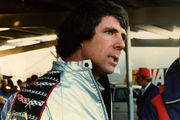
At the height of his NASCAR Winston Cup success in the early 1980s, fans often booed Waltrip, in large part because of his success on the track defeating more established drivers with large fan followings, but also because of his open criticism of NASCAR, his aggressive "take no prisoners", "win at all costs" approach to driving, and his public attempt to be released from his driving contract with DiGard in 1980, a year in which Waltrip won 5 NASCAR Winston Cup races. Still, Waltrip had a huge and devoted fan following. It was often said by race comentators and sports columnist that "you either hate him, or love him". But, Waltrip was at the pinnacle of the sport, constant focus of media attention, and the driver to beat during the early and middle years of the 80's.
Ironically, it was his old rival and long time nemesis Cale Yarborough, the hard-charging, successful driver for Johnson, that privately told Waltrip that he intended to cut back on his racing appearances and leave the highly coveted Junior Johnson team at the end of the 1980 season opening the position for a new driver. Waltrip, the most successful driver at the time was offered the ride by Johnson, if Waltrip could successfully negotiate an early termination of his DiGard contract.
Waltrip bought out his contract with DiGard, driving his final race for them November 15, 1980, freeing him to sign a contract to drive for former moonshine runner, former driver and car owner, the legendary Junior Johnson, starting in the 1981 season. Johnson, the subject of the movie, The Last American Hero (a.k.a. Hard Driver), was convicted in 1956 for making whiskey and served 11 months of a two year sentence,.On December 26, 1986, President Ronald Reagan granted him a presidential pardon for his 1956 conviction. The Junior Johnson prepared cars were considered by most in the sport to be the top ride in NASCAR Winston Cup, at the time.
Junior Johnson years
1981-1986

Waltrip's success driving the Junior Johnson prepared cars even surpassed the highly successful years he had with DiGard. In his first two years as driver for the Mountain Dew sponsored, Junior Johnson prepared Buick Regal, Waltrip won 12 races each year, 14 pole positions in each year, and his first two NASCAR Winston Cup Championships, in 1981 and 1982. Waltrip's success and driving prowess helped bring the Buick GNX into prominence, since he drove a Regal (whose platform spawned the GNX) during his years of sponsorship by Mountain Dew. The company honored the Waltrip years with throwback paint schemes, once in 2006 and again in 2008.
It was during the early 1980s with Junior Johnson that Waltrip first worked with Jeff Hammond, a pit crewman for Johnson. Hammond was at first skeptical of Waltrip's style since it differed so much from the former driver for whom he worked, Cale Yarborough. Yarborough made adjustments to his driving based on the handling of the car in a particular race whereas Waltrip wanted the car adjusted around his driving style. Hammond eventually came to appreciate Waltrip's "finesse" and smooth driving style which proved successful. Waltrip and Hammond would benefit from each others knowledge an abilities and would work together for most of their careers in the sport. Waltrip and Hammond work together even today as broadcaster and analyst at Fox Sports.
During the 1983 Daytona 500, February 20, 1983, Waltrip, a pre-race favorite to win the race, driving the Junior Johnson prepared 1983 Buick Regal Pepsi Challenger, spun on lap 64, at exit of turn 4, at nearly 200 mph, as he was making an evasive maneuver to avoid rear-ending a much slower car ahead of him. Waltrip locked his brakes but the car slid for several hundred feet, then slammed hard into an earthen embankment near the entrance to pit road. The force of the impact was so violent that the car was thrown back onto the track, in front of oncoming traffic. The car then made hard contact again with the outside concrete retaining wall. The car again bounced off the concrete retaining wall, again into oncoming traffic. Cale Yarborough, the eventual winner of the race, barely avoided hitting the demolished Pepsi Challenger. Waltrip suffered a concussion and was taken to nearby Halifax Medical Center for observation. The crash was a wake-up call and a life-changing event for Waltrip. The years following that crash would see a different Darrell Waltrip, one who worked hard to repair and rebuild his relationship with fans and fellow drivers. Eventually, Waltrip would be voted by NASCAR fans "Most Popular Driver", two years in a row, (1989, 1990).
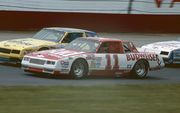
Waltrip would continue his success driving for Junior Johnson through the 1986 NASCAR Winston Cup season, winning his third and final NASCAR Winston Cup Championship, in 1985, winning the inaugural all-star race, The Winston, in 1985, and compiling 43 additional wins. Waltrip drove his final race for Junior Johnson November 16, 1986, in a Chevrolet sponsored by Budweiser, finishing 4th, in the Winston Western 500, Riverside International Raceway in Riverside, California.
Hendrick Motorsports years
1987-1990
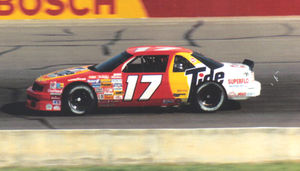
Waltrip's partnership with car owner Junior Johnson led to success with three national championships, and 43 NASCAR Winston Cup wins, but Waltrip saw opportunities elsewhere. Year's before, Waltrip had opened a Honda dealership in his home town of Franklin, Tennessee, with the help of Rick Hendrick, owner of Hendrick Motorsports. Waltrip dreamed of once again owning his own team and, perhaps seeing an opportunity to do so in the future, joined Hendrick Motorsports, with Procter & Gamble detergent Tide as his primary sponsor. The new racecars were painted "dayglow" orange with Tide colors and was the easiest car to find on the track.
In 1987, his first year with Hendrick Motorsports, Waltrip had limited success, compared to his previous year with Johnson. He won only 1 NASCAR Winston Cup race, and had 6 top-five finishes. In 1988, he won 2 NASCAR Winston Cup races, including his fourth Coca-Cola 600 (formerly the World 600) win.
In the 1989 Daytona 500, Waltrip won the race for the first time in his 17th career attempt with a fuel mileage strategy with crew-chief Jeff Hammond, making his final pit stop for fuel 53 laps from the finish. Most of the other cars could run no more than 45 or 46 laps on a tank of fuel, so that meant Waltrip would need to feather the throttle and "draft" off other cars in order to save enough fuel to make it to the finish without an additional stop. Jeff Hammond, interviewed by television pit reporters during the final stint of the race, said that his strategy was for Waltrip to "draft off anybody, and everybody", to save fuel. Even though Waltrip's car ran slower than other cars in the last 53 laps, he was able to avoid making the additional pit stop for fuel the other cars had to make. The strategy provided Waltrip with the track position needed to win the race. His post-race interview with CBS pit reporter Mike Joy, became famous, with Waltrip shouting "I won the Daytona 500! I won the Daytona 500! Wait, this is the Daytona 500 ain't it? ...Thank God!" accompanied by the "Ickey Shuffle" dance in Victory Lane.
Waltrip's popularity as a driver would come full circle on the evening of The Winston, May 21, 1989, at Lowe's Motor Speedway. On the final lap, Waltrip was leading the race when Rusty Wallace hit Waltrip's car exiting the 4th turn and spun Waltrip to the infield costing him the victory and the $200,000 purse. Not only was Waltrip and his crew upset at being knocked out of the victory, the 150,000 fans watching the race issued boos to the winner, Rusty Wallace. The two crews scuffled in the pits and harsh words were said after the race. Waltrip was quoted after the race as saying "I hope he chokes on it", meaning the $200,000 that Wallace collected for the victory. During the 1989 and 1990 seasons, Waltrip was voted Most Popular Driver by the fans.
Waltrip would win 6 NASCAR Winston Cup races in 1989, his best year with Hendrick Motorsports, and help develop NASCAR’s version of the new Chevrolet Lumina in 1989, and delivered its first victory by winning an unprecedented fifth Coca-Cola 600 (formerly the World 600), that May. Besides establishing a race record for victories, the win prepared him for a chance to win the one remaining "major race" which had eluded him since his first race at the Heinz Southern 500 in Darlington, SC. A Darlington victory would award him a one million dollar bonus for winning three of the sport's four majors in the same season — the Daytona 500, the Aaron's 499, Coca-Cola 600, and the Mountain Dew Southern 500. The pressure of both the million dollar bonus and Career Grand Slam (at Talladega, he had won the 1977 and 1982 Winston 500, which were his first and fourth career wins in majors) affected Waltrip badly. He hit the wall early in the 1989 Southern 500 and was never a contender.
For many reasons, Waltrip was unable to carry his success of the previous year into 1990. Waltrip failed to visit victory lane all season although he actually won a NASCAR Winston Cup race for which he is officially posted as finishing 2nd. The win came April 22, 1990, in the First Union 400, at North Wilkesboro Speedway in North Wilkesboro, North Carolina, in his final year with Hendrick Motorsports. 1990 was the first year since 1974, that Waltrip did not win a race, at least “officially”, a point that is especially disappointing for Waltrip, and for crew chief, Jeff Hammond. Brett Bodine was credited with the official victory, although NASCAR, and even Larry McReynolds, the crew chief at the time for Brett Bodine later admitted to Waltrip, that Bodine didn’t win the race. Jeff Hammond, Waltrip’s crew chief, appealed to NASCAR officials. Waltrip even protested to NASCAR head Bill France, Jr. Although France knew that a scoring error had been made, Bodine had already been declared the race winner. According to Waltrip, France told him to “leave that boy alone, D.W., that’s his first win and you are going to win a lot more races.“ The controversy was the result of a scoring error on the part of NASCAR when the pace car picked up the wrong car after a caution flag. NASCAR spent 18 laps of caution attempting to discover where the error was made. This was before the current computerized timing and scoring technology was used. Bodine actually finished the race on the tail end of the lead lap almost a full lap behind Waltrip, but is officially credited with the victory, the only victory of his career.
Much of the Hendrick Motorsports team’s focus and resources had earlier been devoted to providing numerous racing "movie" cars and drivers for the movie Days of Thunder , a 1990 American romantic drama film released by Paramount Pictures and produced by Don Simpson and Jerry Bruckheimer and directed by Tony Scott, starring Tom Cruise, Nicole Kidman, Robert Duvall, Randy Quaid, Cary Elwes and Michael Rooker. The film also features appearances by real life racers, such as Rusty Wallace, Neil Bonnett, and Harry Gant. Commentator Dr. Jerry Punch, of ESPN, has a cameo appearance, as does co-producer Don Simpson. The movie was a fictional account based loosely on NASCAR characters, the car-owner character a composite of several owners, one of whom was Rick Hendrick, owner of Hendrick Motorsports.
While practicing for his 500th career start at the Pepsi 400 at Daytona, Waltrip spun out in another car's oil, and was T-Boned by driver Dave Marcis. Waltrip suffered a broken arm, a broken leg, and a concussion. He missed the Pepsi 400, but came back to run one lap at Pocono, before giving way to Jimmy Horton as a relief driver. Despite missing the next five races due to his injuries, Waltrip still finished 20th in driver points and the team finished 5th in owner points with substitute drivers taking turns in the car — Greg Sacks' second place finish at Michigan in August was the best finish of the team's season. The Jeff Hammond-led team scored only one DNF for the season, when Sarel van der Merwe crashed late in the race at Watkins Glen.
Owner/Driver years
After his 4th season with Hendrick Motorsports , Waltrip formed his own team to field cars in the 1991 NASCAR Winston Cup season. Driving his own cars had been his passion since he successfully drove his own cars in his early NASCAR career in the early and mid-70’s. He would continue his relationship with Chevrolet and drive a Chevrolet Lumina with Western Auto as the primary team sponsor. Waltrip purchased his team and racing facilities from his former owner Rick Hendrick in Charlotte, North Carolina, and hired Jeff Hammond as crew chief. Waltrip and Hammond enjoyed much success together as Hammond had been with Waltrip during the championship winning years with Junior Johnson, and most of the Hendrick Motorsports years, and was Waltrip's crew chief for his 1989 Daytona 500 win and 3 of his 5 Coca-Cola 600 (formerly the World 600) wins.
In the 1991 season, Waltrip visited victory lane twice, his first win in his second stint as owner/driver came in only the 7th race of the ’91 season on April 21, 1991, in the First Union 400, at North Wilkesboro Speedway in North Wilkesboro, North Carolina. His second win of the year came in the 13th race of the season on June 16, 1991, in the Champion Spark Plug 500, at Pocono Raceway, in Long Pond, Pennsylvania.
Just two races after celebrating his second win of 1991, Waltrip would again be involved in a serious crash, again at the Daytona International Speedway, in Daytona Beach, Florida. It came after completing the 119th of 160 laps on the 2.5 mile super speedway. Waltrip and driver Alan Kulwicki were racing side by side, leading a large grouping of cars, battling for 5th position. The car drafting Alan Kulwicki bumped the Kulwicki car, causing his car to hit Waltrip’s Western Auto Chevrolet at speeds approaching 200 mph on the long backstretch. Waltrip’s car slowed and was collected by driver Joe Ruttman’s car, both cars sliding sideways several hundred feet on the grassy infield. Waltrip’s car caught the edge of an access road causing it to become airborne and tumbling several times before coming to a stop, up-side down, in a grassy area near turn 3. Waltrip was extricated and only suffered minor injuries but many feared that he could have re-injured his shattered leg from the crash at the same track the previous year. Waltrip still had a plate in his left leg from the compound fractures he suffered. Waltrip would compete in the following race, being the 2nd race at the Pocono Raceway, in Long Pond, Pennsylvania, but was crashed again when driver Ernie Irvan spun driver Hut Stricklin in front of almost the entire field. Waltrip won the year's 1st race at the track just 5 weeks before.
Waltrip finished the first year of his second stint as owner/driver 8th in the overall NASCAR Winston Cup points championship, after being as high as 3rd place after 14 races. His first year was generally viewed as a successful first year outing. However, Waltrip was now 44 years old, had children, and many pressures as owner/driver that he didn’t concern himself with driving for multi-million dollar, highly financed teams such as Hendrick Motorsports.
In 1992, Waltrip collected three more wins, including finishing off a career Grand Slam by winning the Mountain Dew Southern 500, a race held at Darlington Raceway in Darlington, South Carolina, USA, September 6, 1992, (the last major race which had eluded his 20-year career), and finished 9th in points, after being as high as 6th after 22 races. That would be Waltrip’s 84th and final career victory, tying him with driver Bobby Allison for third on the all-time list, behind Richard Petty, with 200 wins, and David Pearson, with 105 wins.
In 1993, Waltrip signed former Richard Childress Racing engine builder Lou LaRosa to build engines, and Barry Dodson, a former championship winning crew chief. He posted four top ten finishes, but didn't finish higher than third. 1994 saw him make his final appearance in the top ten in championship points by finishing 9th. He had a then-unprecedented streak over two seasons of 40 races without a DNF, all with own in-house engines. His only engine failure in the season was after the car crossed the finish line. Waltrip finished 16th in points in 1995 when he crashed at The Winston, and was forced to let relief drivers take over for several weeks. His second half of the season was highlighted by his final career pole at the NAPA 500.
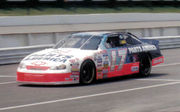
In 1996, Waltrip posted two top-ten finishes. Western Auto remained the sponsor as part of Waltrip's 25th anniversary celebration. While the year was one of Waltrip's most profitable, his results continued to fall off.
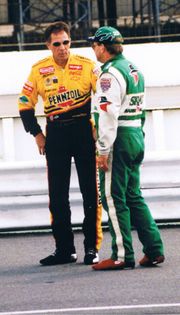
At the 1997 UAW-GM Quality 500, Waltrip failed to qualify for the first time in over 20 years as Terry Labonte also failed to make the race. Because Labonte was a more recent Cup champion (in fact, he was the defending Cup champion that season), he was able to take the past champion's provisional. Waltrip, who was 20th in owner points, was too low in the owner points position to make the race (only the top four in owner points of cars not in the field, excluding the most recent former champion not in the field, were added after qualifying under 1997 rules). After the season, Waltrip and his team were struggling to find sponsors, but were able to put together a last-minute deal with the Ohio-based company Speedblock for 1998. Speedblock only paid portions of what was promised, and the deal was canceled. Waltrip’s team at this point was nearly bankrupt, and he sold the team to Tim Beverly.
Beverly chose not to race the team immediately, instead choosing to rebuild the team (now part of Dale Earnhardt, Inc. after two sales and a merger). During this time, Waltrip signed with Dale Earnhardt, Inc. to drive the #1 Pennzoil Chevy, filling in for injured rookie Steve Park. During his tenure with DEI, Waltrip posted a fifth place finish at the California 500, and led in the final stages of the Pocono 500 and finished in the sixth spot. In 2008, Waltrip admitted the reason that he failed as a driver-owner team was because he only thought like a driver, not as an owner.[1]
Waltrip officially won 84 NASCAR races, but one additional uncounted "win" was as relief driver for Donnie Allison at the 1977 Talladega 500. Allison received credit as he started the race. In that race, Waltrip dropped out after 106 laps. Allison sought a relief driver for his #1 Hawaiian Tropic car due to the excess heat of the day and Waltrip stepped up to complete the race in Allison's car. The irony was that Waltrip replaced Allison at the DiGard #88 race team just two years previously, which was part of the long lore of the Allisons vs Waltrip battle for 16 years.
His 84 wins in the Cup series are tied for third place in NASCAR history, with Bobby Allison, and are the most in the "modern era" of NASCAR, which began in 1972 with rationalization of the schedule and elimination of dirt-track races from the Cup series.
Final years
At the Brickyard 400, Beverly did return the team as the #35 Chevrolet Monte Carlo with Tabasco sauce sponsorship. A sponsorship conflict with Tabasco would switch the team to the Pontiac Grand Prix. Waltrip resigned at the end of the season. After a brief flirtation with retirement, Waltrip signed to drive the #66 Big K Ford Taurus for Haas-Carter Motorsports and teammate with Jimmy Spencer. Waltrip failed to qualify seven times during that season with a new qualifying rule for the Past Champion's Provisional. During his retirement year of 2000, Waltrip's best run came at the Brickyard 400, where he qualified on the outside pole and finished eleventh. His final race came November 19, 2000, in the Napa 500, at the Atlanta Motor Speedway, where he posted a 34th place finish in the Haas-Carter Motorsports owned #66 Route66 Big K Ford Taurus. He finished 36th in points that season.
Craftsman Truck Series
In 1995, Waltrip built a Craftsman Truck Series team, and found success by 1997, when Rich Bickle finished second in overall season standings and winning three races, and made Waltrip one of a few car owners to have won races in NASCAR's three national series. When Sears ceased sponsorship of both teams in 1997, he suspended the Truck team, not returning until 2004 as part of Toyota's NASCAR development.
Announcing career
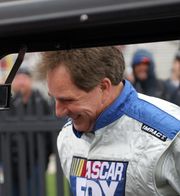
After his 2000 retirement, he signed with Fox to be the lead analyst on the network's NASCAR telecasts, teamed with Mike Joy and Larry McReynolds. Waltrip had done several IROC broadcasts prior to his signing during the 1999 and 2000 seasons.
Waltrip began his career with Fox by calling the 2001 Daytona 500. His brother Michael Waltrip won the race, but Michael's victory was overshadowed by the tragic death of Dale Earnhardt.
A week after Daytona, Waltrip interviewed NASCAR President Mike Helton for a pre-race segment during the broadcast at North Carolina Speedway (Rockingham). Waltrip believed that four deaths in the previous ten months, all caused by basilar skull fractures incurred in accidents, was too many, and he was not shy about asking Helton for an explanation. Helton's responses irritated Waltrip, who was referred by one magazine as "acting a lot more like the next Mike Wallace (of 60 Minutes) than the next John Madden."
He then pushed for mandatory head-and-neck restraints, and two weeks later, demonstrated the device during the broadcast in Atlanta Motor Speedway, explaining the device. Seven months later, NASCAR mandated the devices after a crash during an ARCA Re/Max Series race held after qualifying for the UAW-GM Quality 500 killed driver Blaise Alexander.[2]
As the cars take the green flag to start each race, Waltrip shouts "Boogity, boogity, boogity, let's go racing boys!" This somewhat nonsensical phrase has become Waltrip's trademark in recent years. (The phrase "boogity, boogity, boogity" also appears in the 1960 doo wop parody "Who Put the Bomp" by Barry Mann.) Jerry Reed also said this phrase in the 1977 movie "Smokey and the Bandit." Waltrip explained that the catchphrase arose because, as a driver, he grew tired of hearing his spotter or crew chief say "green, green, green" at the start of every race and wanted to hear something more original. The catchphrase is always preceded by fellow analyst and former crew chief Larry McReynolds telling Waltrip to "reach up there and pull those belts tight one more time!"
He also lends his unique wordings to his commentary, talking about "co-opitition" when racers work together, but keep each other under a watchful eye, "s'purnce" when talking about driving skills of a veteran driver, and "using the chrome horn", when a driver somewhat purposefully bumps a car that's in the way (bumpers on cars used to be made of metal and coated in chrome). In early 2007, Waltrip was nominated for an Emmy in the category "Outstanding Event Analyst".
Currently
Waltrip fielded a Toyota sponsored by Japanese industrial giant NTN for his Craftsman Truck Series team in 2004. David Reutimann drove the truck for the team and earned Rookie of the Year honors that year. Waltrip's team expanded to two trucks in 2005. In August 2005, the revived Darrell Waltrip Motorsports won its first race, the Toyota Tundra 200 at Nashville Superspeedway with Reutimann driving. During the 2007 season, A.J. Allmendinger drove the #00 Red Bull Toyota but with minimal success. By years end the team was sold to The Racer's Group. a road racing operation.
Waltrip has made occasional starts (three or less each year) in the Craftsman Truck Series and Busch Series since his "retirement" in 2000. Each of these races have been either at Martinsville Speedway or Indianapolis Raceway Park.
Waltrip was the honorary starter at the 2007 Food City 500 and was also the honorary starter for the 2008 Gatorade Duel as Gatorade was one of Waltrip's former sponsors. He also started/completed a Busch Series race at Martinsville in his brother's "Aaron's Dream Machine".
In 2009, he appeared in commercials for Rejuvenate Auto with his #11 Mountain Dew Chevrolet. Waltrip also appeared in Fox public service announcements for breast cancer awareness.
Legacy
Waltrip is recognized by many who closely follow motorsports as NASCAR's first "total package" driver. He was media saavy, articulate, attractive and possessed the driving skills that would take him to the top of the sport. His style attracted big-budget sponsors that are necessary to fund the multi-million dollar NASCAR teams. Today, it is customary for the team's sponsor to have considerable input into who the team's driver will be that represents their brand or product on the track. Today's NASCAR driver fits the mold that Waltrip first ushered in to NASCAR.
As a Fox Sports broadcaster, Waltrip's opinions, views and comments carry considerable weight with drivers, team owners, fans and Nascar heads. Waltrip has never been shy about expressing his views, even if controversial. His critical comments about safety have played a significant role in many safety innovations current driver's enjoy today.
Waltrip has been a design consultant on some of the newer tracks including the Kentucky Motor Speedway, and the Nashville Superspeedway.
Waltrip has a building which holds many of the race cars he drove throughout his career.
Media appearances
Film and television
Waltrip's entertainment appearances were influenced by his early 1970s work with Ralph Emery in Nashville radio, and that led to his work as a fill-in for Emery.
In the 1980s and 1990s, he would substitute for Emery on The Nashville Network's Nashville Now and later hosted himself the network's two successor variety shows, "Music City Tonight" and "Prime Time Country".
Waltrip worked on Days of Thunder as Hendrick Motorsports was a major provider of cars and drivers (he helped hire Bobby Hamilton for the project), and one of his injury substitutes was lead stunt driver Greg Sacks.
Waltrip has twice been a presenter at the GMA (Gospel Music Association) Music Awards, partnering with Kathy Troccoli both times. In 1999, they presented the "Song of the Year" award to Mitch McVicker and Rich Mullins for "My Deliverer". Rich Mullins and Mitch McVicker were thrown from their truck after not wearing seat belts, and Mullins was killed in the accident.
In 2006, Waltrip and Nicole C. Mullen hosted a DirecTV special, Songs of Faith. Also in 2006, he played a color commentator for the Disney/Pixar movie Cars. He played the role as Darrell Cartrip, an obvious pun on his name. He also appeared in the broadcast booth in the movie Talladega Nights: The Ballad of Ricky Bobby where his phrase was "in racing you have good days and bad days and Ricky Bobby just had himself a bad day". On December 15, 2006, Waltrip played the role of "Mother Ginger" in the Nashville Ballet's production of The Nutcracker.
He currently appears in advertisements for Toyota and Aaron Rents alongside his brother, Michael, where his gimmick is constantly asking Michael's permission to drive the Aaron's Dream Machine (a nickname for the #99 Nationwide Series car). Waltrip has also made a number of appearances in "comedic" segments appearing during his actual Fox broadcasts.
He was featured in two NASCAR Series videos Darrell Waltrip: Quicksilver which explained Waltrip's career and future and he appeared in the NASCAR Video series where he teaches helpful driving tips for driving on the freeway and long-distance drives.
Books and magazines
Waltrip has also been successful in the publishing field. In September 1994, he was featured as the cover story in Guideposts.
His autobiography, DW: A Lifetime Going Around in Circles, was a New York Times best-seller when it was released around the 2004 Daytona 500. The book was co-written with Jade Gurss.
In May 2004, Waltrip became the second sports figure to be featured in former NBA player and basketball coach Jay Carty's One-on-One series of devotional books. Darrell Waltrip One-on-One: The Faith that Took Him to the Finish Line is a sixty-day devotional book featuring Waltrip's stories and how they can relate to faith, and Carty's devotionals. (The series also features John Wooden and Mike Singletary.)
See also
- Michael Waltrip
- Darrell Waltrip Motorsports
References
- ↑ "Fox Sports on MSN - Darrell Waltrip - Smoke wants to do it his way". Msn.foxsports.com. http://msn.foxsports.com/nascar/story/8327774/Smoke-wants-to-do-it-his-way. Retrieved 2010-09-07.
- ↑ "SPORT: NASCAR 2001, Shaken but Not Shattered - - Car and Driver - June 2001". Car and Driver. http://www.caranddriver.com/article.asp?section_id=4&article_id=3451&page_number=2. Retrieved 2010-09-07.
External links
| Preceded by Dale Earnhardt |
NASCAR Winston Cup Champion 1981-82 |
Succeeded by Bobby Allison |
| Preceded by Terry Labonte |
NASCAR Winston Cup Champion 1985 |
Succeeded by Dale Earnhardt |
| Preceded by Bobby Allison |
Daytona 500 Winner 1989 |
Succeeded by Derrike Cope |
| Preceded by Bill Elliott |
Bill Elliott Award 1989-90 |
Succeeded by Bill Elliott |
|
|||||||||||||||||
|
|||||||||||||